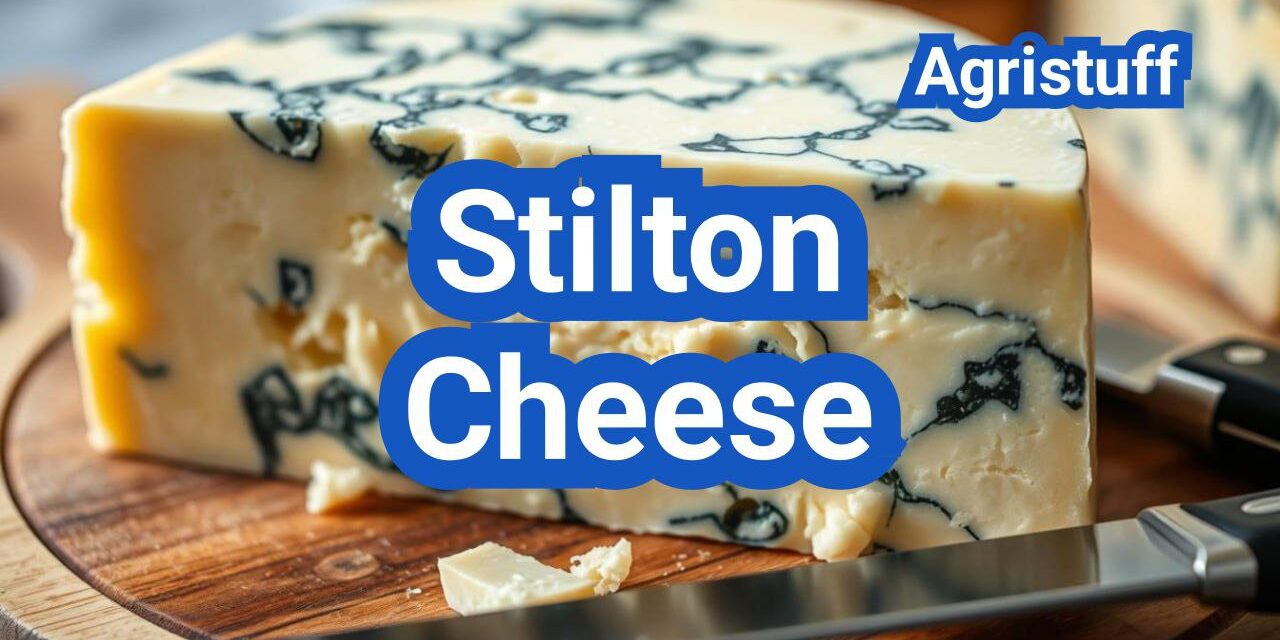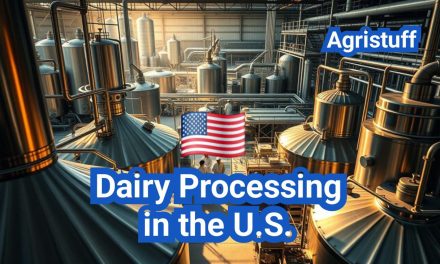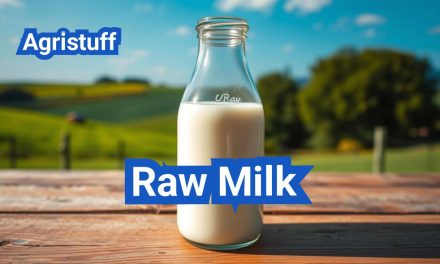Stilton cheese is a celebrated English blue cheese known for its rich history and complex flavor profile, and consider as soft cheese With a protected designation of origin, it has been a staple in British cuisine for centuries.
Produced in specific counties in England, this cheese is enjoyed for its creamy texture and tangy, slightly sweet flavor. The history of Blue Stilton PDO dates back to the early 18th century, and it is named after the village of Stilton, where it was sold to travelers.
This section will explore the origins, types, and traditional uses of this renowned cheese, setting the stage for a deeper dive into its production process and nutritional value.
Key Takeaways
- Stilton cheese has a protected designation of origin.
- It is known for its creamy texture and tangy flavor.
- The history of Stilton cheese dates back to the 18th century.
- There are different types of Stilton cheese, including Blue Stilton PDO.
- Stilton cheese is a staple in British cuisine.
The Rich Heritage of Stilton Cheese
Stilton cheese is one of the most renowned English blue cheeses, with a history dating back to the early 18th century. Its origins are deeply rooted in the English countryside, specifically in the counties of Derbyshire, Leicestershire, and Nottinghamshire.
Origin and Historical Development in England
The production of Stilton cheese began in the early 1700s in the midlands of England. The cheese was initially made by local farmers using traditional methods. The unique flavor and texture of Stilton cheese quickly gained popularity among the local population and travelers alike.
The Village of Stilton Connection
The village of Stilton, located on the Great North Road, played a significant role in the cheese’s history. Travelers stopping at the village’s coaching inns would purchase Stilton cheese to take with them on their journeys. This helped spread the cheese’s reputation across the country.
Evolution Through the Centuries
Over time, Stilton cheese has evolved, but its traditional production methods have remained largely unchanged. The cheese has adapted to changing consumer tastes while maintaining its distinctive characteristics. The Protected Designation of Origin (PDO) status granted to Stilton cheese in 1996 ensured that only cheese produced in specific areas could be labeled as “Stilton.”
Today, Stilton cheese continues to be produced using traditional techniques, with a focus on quality and authenticity. The rich heritage of Stilton cheese is a testament to the enduring appeal of this iconic English blue cheese.
Understanding Stilton Cheese: The King of English Blue Cheeses

Authentic Stilton cheese is a product of tradition and geography, adhering to specific guidelines that ensure its quality and uniqueness. To be considered genuine Stilton, the cheese must be produced within a defined region in England, following a traditional method that has been preserved over centuries.
What Defines Authentic Stilton Cheese
Authentic Stilton cheese is characterized by its production process and geographical origin. It must be made in one of three counties in England: Derbyshire, Leicestershire, or Nottinghamshire. The cheese is known for its rich, buttery flavor and the presence of blue veining, which is a result of the introduction of Penicillium roqueforti during the cheese-making process.
The characteristics of authentic Stilton include:
- A rich, tangy flavor profile
- A crumbly texture with blue veining
- Production within specific counties in England
- Adherence to traditional manufacturing methods
Protected Designation of Origin (PDO) Status
Stilton cheese has been awarded the Protected Designation of Origin (PDO) status, a designation that protects the name of the product and ensures that it is produced, processed, and prepared within a specific geographical area using traditional methods. This status is a guarantee of the cheese’s authenticity and quality, safeguarding the traditional production methods and the region’s reputation.
“The PDO status for Stilton cheese is a testament to its unique heritage and the strict production standards that must be adhered to.”
European Commission
The Stilton Cheese PDO Logo and Its Significance
The Stilton Cheese PDO logo is a symbol of authenticity and quality, signifying that the cheese has met the stringent criteria set forth by the PDO regulations. The logo is a guarantee that the Stilton cheese has been produced according to traditional methods within the designated geographical area.
Consumers can look for the PDO logo when purchasing Stilton cheese, as it ensures they are buying a genuine product that adheres to the highest standards of quality and tradition.
The Two Official Types of Stilton Cheese
Stilton cheese comes in two PDO-approved types, offering a range of flavors and textures. These are Blue Stilton PDO and White Stilton PDO, each with its unique characteristics and uses in cuisine.
Characteristics of Blue Stilton PDO
Blue Stilton PDO is the more well-known variety, characterized by its distinctive blue-green veining. This veining is a result of the introduction of Penicillium roqueforti during the cheese-making process. The flavor profile of Blue Stilton is robust and tangy, making it a favorite among cheese connoisseurs.
The Lesser-Known White Stilton PDO
White Stilton PDO, on the other hand, is a milder cheese that is often used in desserts or paired with fruit. It lacks the blue veining of its counterpart and has a creamy texture. White Stilton is an excellent choice for those who prefer a less pungent Stilton experience.
Differences Between Blue and White Stilton
The primary differences between Blue Stilton PDO and White Stilton PDO lie in their appearance, flavor, and usage. Blue Stilton is veined with blue-green mold and has a strong, tangy taste, while White Stilton is mild and creamy. These differences make them suitable for different culinary applications.
Key differences include:
- Appearance: Blue Stilton has blue-green veining, while White Stilton is uniform in color.
- Flavor: Blue Stilton is robust and tangy; White Stilton is mild.
- Usage: Blue Stilton is often served as a cheese course, while White Stilton is commonly used in desserts or with fruit.
Both types of Stilton cheese are protected by PDO status, ensuring that their production adheres to traditional standards and methods.
How to Recognize Quality Stilton Cheese

The art of recognizing premium Stilton cheese lies in understanding its visual, textural, and flavor profiles. Quality Stilton cheese is characterized by its distinctive veining, crumbly yet creamy texture, and rich, tangy flavor. To appreciate the nuances of Stilton, one must learn how to evaluate these characteristics effectively.
Visual Indicators of Premium Stilton
When assessing Stilton cheese, the first step is to visually inspect its appearance. Premium Stilton should display a characteristic blue veining throughout the cheese, with the veining being evenly distributed. The color of the veining can range from a deep blue to a greenish-blue, depending on the age and type of Stilton. The overall color of the cheese should be a creamy white or off-white, providing a striking contrast to the blue veining.
Key visual indicators include:
- Even distribution of blue veining
- Deep, rich color of the veining
- Clean, unblemished surface
Texture Assessment Techniques
Texture is a crucial aspect of Stilton cheese, with premium varieties offering a crumbly yet creamy mouthfeel. To assess the texture, gently press the cheese or cut into it. High-quality Stilton should yield to pressure but still retain some firmness. When cut, the cheese should have a slightly open texture, allowing the blue veining to be visible.
Texture assessment involves:
- Gently pressing the cheese to check for yield and firmness
- Cutting into the cheese to inspect its internal texture
- Noting the presence of a slightly open texture that showcases the veining
Aroma and Flavor Evaluation Methods
The aroma and flavor of Stilton cheese are perhaps its most distinctive features. Premium Stilton has a rich, tangy flavor with a slightly sweet undertone, accompanied by a pungent aroma. When evaluating the flavor, pay attention to the balance between the tanginess of the blue veining and the creaminess of the cheese. The finish should be long and satisfying, with the flavors lingering pleasantly.
Flavor and aroma evaluation involves:
- Noting the intensity and balance of flavors
- Assessing the pungency and character of the aroma
- Evaluating the finish for length and complexity
By carefully assessing these aspects, one can confidently identify quality Stilton cheese. Whether you’re a cheese aficionado or just discovering the delights of Stilton, understanding these evaluation techniques will enhance your appreciation of this iconic English cheese.
The Complete Stilton Cheese Making Process
Stilton cheese production is a complex, multi-step journey that transforms raw milk into a rich, tangy delight. This process involves careful milk selection, curd formation, and a unique aging process that gives Stilton its characteristic flavor and texture.
Step1: Milk Selection and Preparation
The journey begins with the selection of high-quality cow’s milk. The milk used for Stilton cheese production is typically rich in fat and protein, which are essential for developing the cheese’s distinctive flavor and texture. The milk is pasteurized to eliminate any harmful bacteria while preserving its natural goodness.
Milk Quality Parameters:
| Parameter | Value |
|---|---|
| Fat Content | 3.5% – 4% |
| Protein Content | 3.2% – 3.5% |
| pH Level | 6.5 – 6.7 |
Step2: Curd Formation and Cutting
The pasteurized milk is then curdled using rennet, a natural enzyme that helps to coagulate the milk. The curdling process typically takes about 30-45 minutes, during which the milk transforms into a solid curd and liquid whey. The curd is then cut into small pieces to release more whey and create a smooth, even texture.
“The quality of the curd is crucial in determining the final texture and flavor of the Stilton cheese. Cheesemakers must carefully monitor the curdling process to achieve the perfect balance.”
Step3: The Unique Stilton Piercing Process
One of the most distinctive steps in Stilton cheese production is the piercing process. After the curd has been molded and allowed to drain, the cheese is pierced with stainless steel wires or skewers. This process introduces oxygen into the cheese, encouraging the growth of blue-green mold (Penicillium roqueforti) throughout the cheese.
Step4: Aging and Maturation Requirements
The final stage in Stilton cheese production is the aging process. The cheese is aged for a minimum of nine weeks, during which it is regularly turned and monitored for quality. The aging process allows the flavors to mature and the characteristic blue veining to develop fully.
Aging Requirements:
- Minimum aging period: 9 weeks
- Temperature range: 7°C – 10°C (45°F – 50°F)
- Humidity level: 90% – 95%
By following this meticulous process, Stilton cheesemakers can produce high-quality cheese that meets the stringent standards required for PDO status.
Essential Equipment for Stilton Cheese Production

The production of Stilton cheese relies on a combination of traditional and modern equipment. Cheesemakers use a range of tools and machinery to ensure the quality and consistency of this iconic English cheese.
Traditional vs. Modern Manufacturing Tools
Stilton cheese production has evolved over the centuries, incorporating both traditional methods and modern technology. Traditional equipment includes wooden cheese boards and stainless steel vats, while modern tools encompass advanced curd-cutting machinery and automated temperature control systems.
Traditional Equipment: Wooden boards for aging, stainless steel vats for curdling, and manual stirring tools.
Modern Equipment: Automated curd-cutting machines, temperature and humidity control systems, and stainless steel molds.
Specialized Equipment for Blue Veining
The distinctive blue veining in Stilton cheese is achieved through a process known as “piercing,” where the cheese is pierced with stainless steel needles to introduce oxygen and encourage the growth of Penicillium roqueforti. This mold is responsible for the cheese’s characteristic flavor and appearance.
Aging Rooms and Environmental Control Systems
Aging rooms play a crucial role in Stilton cheese production, providing a controlled environment for the cheese to mature. These rooms are equipped with sophisticated temperature and humidity control systems to maintain optimal conditions.
| Equipment | Description | Function |
|---|---|---|
| Stainless Steel Vats | Large containers for curdling milk | Curdling and initial cheese formation |
| Curd-Cutting Machines | Automated tools for cutting curds | Releasing whey and creating uniform curd size |
| Aging Rooms | Controlled environments for cheese maturation | Temperature and humidity control for optimal aging |
By combining traditional techniques with modern equipment, Stilton cheese producers can ensure the highest quality and consistency in their products.
The Role of Penicillium Roqueforti in Stilton

Stilton cheese owes its unique appearance and flavor profile to the introduction of Penicillium roqueforti during the cheese-making process. This type of mold is crucial for developing the characteristic blue-green veining that Stilton is known for.
Creating Blue Veining
The process of creating the blue veining involves introducing Penicillium roqueforti spores into the cheese. As the cheese ages, these spores germinate and grow, forming the distinctive veins. The development of this mold is carefully controlled to achieve the desired veining pattern and intensity.
The environment within the aging room is crucial for the growth of Penicillium roqueforti. Factors such as temperature, humidity, and oxygen levels are monitored to ensure optimal conditions for the mold to develop. This careful control allows producers to achieve a consistent quality in the final product.
Differences in Mold Cultures
While Penicillium roqueforti is used in several types of blue cheese, the specific strain and the way it’s cultivated can vary between different cheeses. Stilton cheese producers use a particular method of introducing and nurturing the mold to achieve the characteristic veining and flavor profile associated with Stilton.
In comparison to other blue cheeses like Roquefort, the mold culture in Stilton is managed differently, resulting in a unique taste and appearance. This difference is part of what gives Stilton its distinct identity among blue cheeses.
Safety and Quality Control
Ensuring the safe development of Penicillium roqueforti is critical for producing high-quality Stilton cheese. Producers follow strict guidelines to prevent contamination and ensure that the mold grows as intended. Regular checks are performed during the aging process to monitor the mold’s development and the overall condition of the cheese.
Quality control measures also include assessing the flavor, texture, and appearance of the cheese. Only cheeses that meet the required standards are certified as authentic Stilton, guaranteeing consumers a product that is both safe and of high quality.
Stilton Cheese Taste Profile and Sensory Evaluation

The taste profile of Stilton cheese is a complex blend of flavors that evolves significantly as it ages. This evolution is a key characteristic that makes Stilton so revered among cheese connoisseurs.
Flavor Characteristics at Different Maturity Stages
Stilton cheese undergoes a significant transformation in flavor as it matures. Young Stilton tends to be milder and creamier, with a subtle tanginess. As it ages, the flavor becomes more pronounced, developing a rich, tangy taste with hints of fruit and nuts.
- Young Stilton: Mild, creamy, subtle tanginess
- Mature Stilton: Rich, tangy, with hints of fruit and nuts
- Vintage Stilton: Complex, intense, with a long finish
Texture and Mouthfeel Analysis
The texture of Stilton cheese is another critical aspect of its sensory profile. It is typically crumbly, yet it retains a creamy element that contributes to its luxurious mouthfeel. When assessing Stilton, pay attention to its texture: a high-quality Stilton should have a smooth, even veining of blue mold throughout.
Vintage Stilton Flavor Complexity
Vintage Stilton represents the pinnacle of Stilton cheese production. Aged for a longer period, Vintage Stilton develops an incredibly complex flavor profile, with intense notes of fruit, nuts, and a deep, tangy sharpness. The aging process allows the cheese to develop a rich, crumbly texture and a long, satisfying finish.
Conducting Your Own Stilton Tasting
To fully appreciate the nuances of Stilton cheese, conducting a tasting is highly recommended. Here are some steps to follow:
- Select a variety of Stilton cheeses at different stages of maturity.
- Serve the cheese at room temperature to allow the full range of flavors to be appreciated.
- Use a neutral accompaniment, such as crackers or bread, to cleanse the palate between samples.
- Pay attention to the appearance, texture, aroma, and flavor of each Stilton sample.
- Record your observations to compare and contrast the different Stilton varieties.
By following these steps, you can gain a deeper understanding of Stilton’s unique taste profile and sensory characteristics, enhancing your appreciation of this iconic cheese.
Nutritional Value of Stilton Cheese
Understanding the nutritional content of Stilton cheese can help consumers make informed dietary choices. Stilton cheese is a nutrient-rich food that provides a significant amount of calories, protein, and fat. It is also a good source of calcium, essential for bone health, and contains various vitamins and minerals.
Caloric Content and Macronutrient Breakdown
Stilton cheese is high in calories, primarily due to its fat content. A 100-gram serving of Stilton can contain approximately 370-400 calories. The macronutrient breakdown shows that it is predominantly composed of fat (around 30-35 grams per 100 grams), followed by protein (about 23-25 grams per 100 grams), and a small amount of carbohydrates.
The high fat content in Stilton cheese is primarily saturated fat, which should be consumed in moderation as part of a balanced diet. However, Stilton also contains a significant amount of protein, making it a valuable component of a diet that requires high protein intake.
Vitamins and Minerals in Stilton
Stilton cheese is a rich source of several vitamins and minerals. It is particularly high in calcium, which is crucial for maintaining strong bones and teeth. Additionally, Stilton contains vitamins such as vitamin A, vitamin B12, and riboflavin, which are important for various bodily functions including vision, nerve function, and energy production.
- Calcium: Essential for bone health and development.
- Vitamin B12: Crucial for nerve function and the production of red blood cells.
- Riboflavin (Vitamin B2): Important for energy production and can help reduce the risk of certain diseases.
Health Considerations for Stilton Consumption
While Stilton cheese offers several nutritional benefits, its high calorie and saturated fat content mean it should be consumed in moderation. Individuals with high cholesterol or those on a low-fat diet should be particularly mindful of their Stilton intake.
However, for those looking to increase their protein intake or improve their calcium consumption, Stilton can be a valuable addition to their diet. It’s also worth noting that Stilton, like other cheeses, contains conjugated linoleic acid (CLA), which has been linked to several potential health benefits.
In conclusion, Stilton cheese is a nutrient-dense food that can be part of a healthy, balanced diet when consumed in moderation. Its rich nutritional profile makes it a good source of essential vitamins and minerals, particularly calcium and vitamin B12.
How to Properly Store Stilton Cheese

Effective storage techniques are vital for enjoying Stilton cheese at its peak quality. Proper storage not only maintains the cheese’s flavor but also its texture and overall appearance.
Selecting Appropriate Wrapping Materials
The first step in storing Stilton cheese is to wrap it correctly. Use wax paper or aluminum foil to wrap the cheese tightly. This helps to prevent drying out and contamination. Avoid using plastic wrap as it can trap moisture and encourage mold growth beyond the natural veining.
Maintaining Optimal Temperature and Humidity
Stilton cheese should be stored in the refrigerator at a consistent temperature between 35°F and 45°F (2°C and 7°C). The ideal humidity level is between 80% and 90%. This environment helps to slow down the aging process without drying out the cheese.
| Storage Condition | Ideal Range |
|---|---|
| Temperature | 35°F – 45°F (2°C – 7°C) |
| Humidity | 80% – 90% |
Monitoring Shelf Life and Identifying Spoilage
Regularly inspect your Stilton cheese for signs of spoilage. While some mold is natural, excessive mold or an off smell can indicate that the cheese has gone bad. Generally, Stilton cheese can be stored for several weeks to a few months when properly wrapped and refrigerated.
Freezing Stilton – Techniques and Limitations
While it’s possible to freeze Stilton cheese, this can affect its texture, making it crumbly. To freeze, wrap the cheese tightly in foil or freezer-safe wrap and store it at 0°F (-18°C) or below. Frozen Stilton is best used in cooked dishes where texture isn’t a primary concern.
Guide to Purchasing Quality Stilton Cheese

When it comes to buying Stilton cheese, authenticity is key. Ensuring that you’re purchasing genuine Stilton involves understanding where to buy it, what factors influence its pricing, and identifying reputable producers.
Where to Buy Authentic Stilton
Authentic Stilton cheese can be found in various outlets, including reputable dairy shops and specialty cheese stores. These establishments typically source their products directly from certified producers, guaranteeing the authenticity of the Stilton cheese. Additionally, purchasing directly from the producers or their official websites is a reliable way to obtain genuine Stilton.
It’s essential to look for the Protected Designation of Origin (PDO) logo on the packaging, as this certification ensures that the cheese has been produced according to traditional methods and within the designated area in England.
Understanding Stilton Cheese Pricing Factors
The price of Stilton cheese can vary significantly based on several factors, including the age of the cheese, production methods, and seasonality. Older Stilton cheeses, which have been aged for a longer period, typically command a higher price due to the intensive care required during the aging process.
Furthermore, Stilton produced using traditional methods may be more expensive than those produced on a larger scale. Understanding these factors can help consumers make informed decisions when buying Stilton cheese.
Reputable Stilton Cheese Producers to Look For
Several well-known producers are recognized for their high-quality Stilton cheese. These include Colston Bassett Dairy, Dairy Crest, and Hartington Creamery, among others. These producers adhere to strict quality standards and traditional production methods, ensuring that their Stilton cheese meets the expectations of connoisseurs.
- Colston Bassett Dairy: Known for their traditional Stilton production methods.
- Dairy Crest: Offers a range of Stilton products, including organic options.
- Hartington Creamery: Renowned for their artisanal Stilton cheese.
Seasonal Variations in Availability and Quality
The availability and quality of Stilton cheese can vary with the seasons. Traditionally, Stilton is produced from cow’s milk, and the quality of the milk can be influenced by factors such as the cow’s diet and the time of year. As a result, some producers may offer higher quality Stilton during certain months when the milk is richer and more flavorful.
Consumers should be aware of these seasonal variations when buying Stilton cheese to ensure they are getting the best possible product.
Comparing Stilton Cheese with Other Blue Varieties

When exploring the world of blue cheeses, Stilton stands out for its rich flavor and creamy texture, but how does it compare to other varieties? The world of blue cheese is diverse, with each type offering unique characteristics in terms of taste, texture, and production methods.
Stilton vs. Roquefort: Detailed Comparison Chart
One of the most common comparisons made is between Stilton cheese and Roquefort cheese. While both are considered premium blue cheeses, they differ significantly in their milk source and production processes. Stilton is made from cow’s milk, whereas Roquefort is made from sheep’s milk. This difference contributes to distinct flavor profiles and textures.
| Characteristics | Stilton | Roquefort |
|---|---|---|
| Milk Source | Cow’s Milk | Sheep’s Milk |
| Texture | Creamy | Crumbly |
| Flavor Profile | Rich, Tangy | Sharp, Salty |
Stilton Among Other British Blue Cheeses
Within the UK, there are several other notable blue cheeses. Stilton is often compared to these due to its British heritage. Other British blues, such as Shropshire Blue and Blue Wensleydale, offer different flavor profiles. Stilton’s rich and tangy taste sets it apart, making it a favorite among cheese connoisseurs.
International Blue Cheese Alternatives
For those looking for alternatives to Stilton, international blue cheeses offer a range of flavors. Gorgonzola from Italy and Cabrales from Spain are notable examples. Gorgonzola is known for its creamy texture and mild flavor, while Cabrales is renowned for its strong, pungent taste. These cheeses can be used in various culinary applications, from salads to sauces.
Best Stilton Substitutes When Unavailable
If Stilton is not available, there are several substitutes that can be used depending on the intended use. Other British blue cheeses like Shropshire Blue or Blue Stilton alternatives can be used in recipes. For a similar texture and flavor profile, Gorgonzola or Danish Blue can be considered. The choice of substitute depends on the specific requirements of the dish being prepared.
Creating Perfect Pairings with Stilton Cheese
Stilton cheese is renowned for its rich flavor and versatility in pairings. This English blue cheese has been a favorite for centuries, not just for its taste but also for its ability to complement a wide range of foods and beverages.
The Classic Stilton and Port Wine Combination
The traditional pairing for Stilton cheese is with Port wine. The sweetness of the Port complements the tanginess of the Stilton, creating a balanced flavor profile that is both rich and complex. This classic combination is a staple in many British households, particularly during the holiday season.
The reason behind this pairing lies in the complementary flavor profiles. The sweetness of the Port wine offsets the sharpness of the Stilton, while the cheese’s richness is cut through by the wine’s acidity. This harmonious balance makes the Stilton and Port a timeless duo.
Complementary Foods for Stilton Cheese Boards
When it comes to creating a Stilton cheese board, there are several complementary foods that can enhance the overall experience. Fruits such as pears and grapes are popular choices, as their sweetness pairs well with the savory flavor of Stilton. Nuts, particularly walnuts and almonds, add a satisfying crunch, while crackers provide a neutral base for building bites.
For a more elaborate cheese board, consider adding other artisanal items like chutneys, honey, and fig jam. These additions can introduce new flavor dimensions and textures, making the cheese-tasting experience more engaging and enjoyable.
Beverage Pairings Beyond Port
While Port wine is the classic pairing for Stilton, it’s not the only beverage that complements this cheese. Other wines, such as Sauternes and ice wine, can also pair beautifully with Stilton due to their sweetness and acidity. For those who prefer beer, a rich, malty ale can complement the cheese’s bold flavors.
For a non-alcoholic option, tea can be a surprisingly good match. A strong, black tea like Earl Grey can stand up to the robust flavor of Stilton, while a sweeter tea like chai can provide an interesting contrast.
Seasonal Pairing Suggestions
The versatility of Stilton cheese means it can be enjoyed in various pairings throughout the year. In the winter, richer pairings such as dried fruits and nuts complement the hearty, warming qualities of Stilton. In the summer, lighter options like fresh fruit and crackers can provide a refreshing contrast to the richness of the cheese.
Seasonal beverages also play a role in pairing Stilton. For instance, a warm cider or mulled wine in the winter can enhance the cozy, comforting aspects of Stilton, while a crisp, dry cider in the summer can cut through the richness and refresh the palate.
Cooking with Stilton: Recipe Guide and Techniques
With its rich flavor profile, Stilton cheese offers a world of culinary possibilities for chefs and home cooks alike. This versatile cheese can be used in a variety of dishes, from savory sauces to decadent desserts.
How to Prepare Classic Stilton Cheese Sauce
A classic Stilton cheese sauce is a staple in many British recipes. To make it, you’ll need:
- 1 cup Stilton cheese, crumbled
- 2 tablespoons butter
- 2 tablespoons all-purpose flour
- 1 cup heavy cream
- Salt and pepper to taste
To prepare the sauce, melt the butter in a saucepan over medium heat. Add the flour and whisk to create a roux, cooking for 1-2 minutes. Gradually pour in the heavy cream, whisking continuously until the sauce thickens. Remove from heat and stir in the crumbled Stilton until fully incorporated. Season with salt and pepper to taste.
Incorporating Stilton in Savory Main Dishes
Stilton cheese can elevate many savory dishes, adding depth and complexity to recipes. Some ideas include:
- Stilton and pear salad
- Stilton-stuffed chicken breasts
- Stilton and mushroom risotto
For a simple yet impressive main course, try making Stilton-stuffed chicken breasts. Simply butterfry the chicken, fill with a mixture of crumbled Stilton and chopped herbs, and bake until cooked through.
Dessert Applications for White Stilton
While Blue Stilton is often used in savory dishes, White Stilton is a great addition to desserts. Its mild flavor pairs well with fruit and can be used in cheesecakes, fruit salads, or as a topping for desserts.
One delicious dessert idea is a White Stilton cheesecake. Mix White Stilton with cream cheese, sugar, and vanilla, then pour into a pre-baked crust and chill until set. Top with fresh fruit or a fruit compote for a delicious finish to any meal.
Stilton Cheese Recipe Collection for Every Occasion
Here’s a table summarizing some Stilton cheese recipes for various occasions:
| Recipe | Occasion | Main Ingredients |
|---|---|---|
| Stilton Cheese Sauce | Everyday meal | Stilton, heavy cream, butter |
| Stilton-Stuffed Chicken | Dinner party | Chicken, Stilton, herbs |
| White Stilton Cheesecake | Special occasion | White Stilton, cream cheese, sugar |
| Stilton and Pear Salad | Lunch or starter | Stilton, pears, greens |
The Enduring Legacy of Stilton Cheese
Stilton cheese is a testament to the rich culinary heritage of Britain, with a history that spans centuries. The Stilton cheese legacy continues to be celebrated by cheese enthusiasts around the world, who appreciate its unique flavor and cultural significance.
The Stilton cheese history is deeply rooted in the village of Stilton, where this iconic cheese was first produced. Over time, Stilton has evolved to become one of the most revered blue cheeses globally, known for its distinctive veining and rich, tangy taste.
Today, Stilton cheese remains a staple in many cuisines, from traditional British dishes to modern fusion recipes. Its versatility, coupled with its Protected Designation of Origin (PDO) status, ensures that Stilton continues to be produced with the highest standards of quality and authenticity.
As we reflect on the Stilton cheese legacy, it is clear that this beloved cheese will continue to be cherished for generations to come. Whether enjoyed on its own, paired with fine wines, or incorporated into various recipes, Stilton cheese remains an integral part of British culinary culture.
FAQ
What is Stilton cheese?
Stilton cheese is a renowned English blue cheese known for its rich history and distinctive flavor, produced in specific counties in England and carrying a protected designation of origin (PDO) status.
What are the types of Stilton cheese?
Stilton cheese comes in two varieties: Blue Stilton and White Stilton, both of which have PDO status and are produced according to traditional standards.
What defines authentic Stilton cheese?
Authentic Stilton cheese is defined by its production process and geographical origin, requiring production in one of three counties in England: Derbyshire, Leicestershire, or Nottinghamshire.
What is the significance of the Stilton PDO logo?
The Stilton PDO logo is a guarantee of authenticity and quality, ensuring that the cheese is made according to traditional methods and within the designated production area.
How is Stilton cheese made?
Stilton cheese is made from cow’s milk, which is curdled and then cut into small pieces, molded, and left to drain, followed by a critical piercing process that allows air to enter and encourages the growth of blue-green mold.
What is the role of Penicillium roqueforti in Stilton cheese?
Penicillium roqueforti is a type of mold that is crucial for the development of Stilton cheese’s characteristic blue veining, introduced into the cheese during production and carefully controlled to ensure quality and safety.
How should Stilton cheese be stored?
Stilton cheese should be wrapped in a breathable material like wax paper or foil and stored in the refrigerator at a consistent temperature, with regular monitoring for signs of spoilage.
Where can I buy authentic Stilton cheese?
Authentic Stilton cheese can be purchased from reputable sources, such as specialty stores or directly from the dairy, and should bear the PDO logo.
How does Stilton cheese compare to other blue cheeses?
Stilton cheese is distinct from other blue cheeses like Roquefort, which is made from sheep’s milk, and can be compared to other British blues or international varieties for different flavor profiles.
What are some good pairings for Stilton cheese?
Stilton cheese pairs well with Port wine, fruits like pears and grapes, nuts, and crackers, and can be paired with other wines, beers, and teas for varying flavor combinations.
Can Stilton cheese be used in cooking?
Yes, Stilton cheese is versatile and can be used in a wide range of recipes, including sauces, soups, baked dishes, and desserts, particularly with White Stilton.
Is Stilton cheese healthy?
Stilton cheese is a nutrient-rich food, providing a significant amount of calories, protein, and fat, as well as calcium and various vitamins and minerals, but should be consumed in moderation due to its high fat content.
Can I freeze Stilton cheese?
While Stilton cheese can be frozen, this may affect its texture, and it is generally recommended to store it in the refrigerator to maintain its quality.
What is the difference between Blue Stilton and White Stilton?
Blue Stilton is characterized by its blue-green veining and robust flavor, while White Stilton is milder and often used in desserts or paired with fruit.
Why is Stilton cheese expensive?
The price of Stilton cheese can vary based on factors like age, production methods, and seasonality, with reputable producers adhering to high standards that may impact pricing.
Conclusion of: Stilton Cheese
What is Stilton cheese?
Stilton cheese is Britain’s most famous blue, celebrated for a creamy-crumbly texture, elegant blue veining, and a complex aroma that intensifies with age. Legally, the name “Stilton cheese” may only be used for cheeses made to a strict specification in three English counties—Derbyshire, Leicestershire and Nottinghamshire—using pasteurized cow’s milk and traditional methods. This protected status under the UK’s Geographical Indication (GI) scheme preserves the identity and quality that make Stilton cheese distinctive. UK PDO entry for Blue Stilton
Why Stilton cheese matters to food heritage
Beyond flavor, Stilton cheese embodies a living food tradition with centuries of craft, from farmhouse origins to today’s audited dairies. Protection as a PDO anchors Stilton cheese in place—linking its character to local milk, microbiology, and maker know-how—so when consumers choose Stilton cheese, they can trust its authenticity and provenance. How UK PDOs protect foods
Stilton cheese at a glance: Blue and White
There are two officially recognized styles of Stilton cheese: Blue Stilton (veined with Penicillium roqueforti) and White Stilton (without the blue mold). Both are registered as PDOs in the UK (and recognized in the EU), and both must be produced in the same three counties with pasteurized milk that meets stringent traceability and quality tests. This dual recognition is unusual and underscores the unique identity of Stilton cheese. UK PDO entry for White Stilton
The brief history of Stilton cheese
Written references to Stilton cheese date to the early 18th century, when the Bell Inn at Stilton (a village on the Great North Road) helped popularize the style. Intriguingly, Stilton cheese cannot legally be made in the village of Stilton today because it lies outside the protected counties—an historical twist that highlights how names and trade routes shaped British cheese commerce. Stilton Cheesemakers’ Association – history
Where Stilton cheese can be made (and why that matters)
By law, authenticated Stilton cheese is produced, processed, and prepared only within Derbyshire, Leicestershire, and Nottinghamshire. GI rules require not just geography but method: Stilton cheese must be formed in cylinders, not pressed, and must develop a natural rind under carefully controlled conditions. These rules safeguard the product for UK and international buyers. GI register overview (eAmbrosia/UK)
The recognized types and ages of Stilton cheese
Within the PDO, makers grade Stilton cheese by age and character: standard Blue Stilton (typically ready between 6–12 weeks), Mature Blue (around 10–15 weeks), and Vintage Blue (15+ weeks) with increasingly pronounced complexity. White Stilton has its own specifications and sensorial profile—fresh, clean, and crumbly—often used as a base for fruit-blended desserts. Official PFN specification (PDF)
Who makes Stilton cheese today?
Only a small number of licensed dairies may produce authentic Stilton cheese, and each is independently audited to ensure consistent quality, hygiene, and labeling. Keeping Stilton cheese production concentrated among expert creameries preserves both tradition and high standards that the name promises. Licensed Stilton producers
Milk and culture selection for Stilton cheese
Authentic Stilton cheese starts with pasteurized cow’s milk whose composition is monitored and, if needed, seasonally standardized. Makers add starter cultures (to generate acidity), rennet (for coagulation), and—when making the blue version—Penicillium roqueforti. The result is a well-formed curd primed for Stilton cheese’s open texture and clean flavor. PFN: method & cultures
Processing Step 1 — Curd forming
For Stilton cheese, fresh local milk is poured into an open vat, then inoculated: starters develop acidity, rennet coagulates proteins, and (for Blue) blue mold spores are introduced. Curds are allowed to form and drain—typically overnight—so Stilton cheese begins developing its characteristic open, friable body. How Stilton is made: Stage 1
Processing Step 2 — Hoop filling and turning
Next, Stilton cheese curds are gently milled and hand-ladled into tall cylindrical hoops. Over several days, the hoops are turned on schedule to distribute moisture evenly without pressing. This careful handling ensures Stilton cheese keeps its open texture and forms a natural rind later in maturation. How Stilton is made: hooping & turning
Processing Step 3 — Sealing and “rubbing up”
After the hoops are removed, cheesemakers “rub up” the surface of Stilton cheese—smoothing the exterior to seal tiny openings. Early sealing prevents premature mold development on the rind while Stilton cheese finishes draining and prepares for the long ripening ahead. How Stilton is made: sealing
Processing Step 4 — Ripening under controlled conditions
Ripening rooms for Stilton cheese are strictly controlled for temperature and humidity. Cheeses are turned at intervals for weeks so moisture and microflora develop evenly. This environment cultivates the distinctive texture and buttery complexity that define mature Stilton cheese. How Stilton is made: ripening
Processing Step 5 — Piercing and blue-vein development
At about five to six weeks, wheels of Stilton cheese are pierced with stainless-steel needles. This introduces oxygen, activating P. roqueforti within the curd so the signature blue veining radiates from the core. A second piercing may follow a week later to guide even vein growth across the Stilton cheese. How Stilton is made: piercing
Processing Step 6 — Grading and release
Before release, every batch of Stilton cheese is graded by experts using a cheese iron to assess aroma, flavor, veining, texture, and rind. Only cheeses meeting the PDO standard are sold as Stilton cheese; others are relegated to generic “blue cheese.” Grading ensures consistent eating quality across brands. How Stilton is made: grading
Equipment used to make Stilton cheese
Stilton cheese production relies on specialized but time-tested equipment: open vats, curd knives, curd mills, draining tables, tall cylindrical hoops, turning racks, stainless-steel piercing needles, and controlled-environment ripening rooms. These tools support the PDO method—gentle handling, open texture, and natural rind—at every stage of Stilton cheese making. FAO: small-scale cheesemaking stages
Quality control, traceability, and milk standards
To be sold as Stilton cheese, dairies maintain rigorous records: milk tanker loads are tested on arrival; farms are verified by postcode; and each wheel can be traced back to vat, silo, and collection route. This end-to-end traceability safeguards Stilton cheese for domestic and export markets. PFN: traceability requirements
Flavor and texture: how age shapes Stilton cheese
Blue Stilton cheese opens with a creamy, gently tangy profile and flaky-velvety texture; with longer maturation it becomes softer, rounder, and more savory. Vintage lots show a drier paste and layered, lingering complexity. White Stilton cheese is clean and bright, ideal for blends and desserts. PFN: sensory descriptors by age
How to serve and pair Stilton cheese
For peak flavor, bring Stilton cheese to room temperature before serving. Classic pairings include crackers, plum bread, and sweet wines—especially Port—but rich dessert wines or robust reds also work beautifully. Stilton cheese can also be frozen in portions for up to three months, then thawed gently before use. SCMA: serving & pairing tips
Culinary uses: making the most of Stilton cheese
In the kitchen, Stilton cheese delivers umami and depth: crumble into salads, melt into sauces for steak or pasta, whisk into dressings, or blitz into the UK’s beloved broccoli-and-Stilton soup. Risotto, savory tarts, and baked mushrooms also shine with Stilton cheese’s savory bite. SCMA: recipe ideas
Storage and handling for maximum freshness
Wrap opened Stilton cheese in parchment or foil and store it in the refrigerator in a covered box to avoid cross-aroma. For longer keeping, portion and freeze Stilton cheese; it grates well from frozen and crumbles cleanly when thawed slowly in the fridge. SCMA: storage guidance
Safety note (especially for vulnerable groups)
Because blue-veined cheeses can carry a higher listeria risk for vulnerable groups, public-health bodies advise caution. Even though Stilton cheese is made from pasteurized milk, pregnant people and others at higher risk are often advised to avoid soft blue cheeses unless thoroughly cooked until steaming hot—always follow local guidance. NHS: advice on blue cheeses
How to recognize authentic Stilton cheese
When buying, look for the Stilton cheese name with the UK PDO logo in the same field of vision on packs sold in Great Britain; EU PDO logos apply for cheeses sold in the EU/Northern Ireland. Reputable retailers and cheesemongers will clearly display PDO marks for genuine Stilton cheese. SCMA: labeling & PDO logo rules
Buying tips in the USA
In the U.S., importers bring PDO-certified Stilton cheese from UK creameries; higher-end supermarkets and specialty shops often stock wedges cut from whole cylinders, which maintain moisture better than long-pre-packed pieces. For the best experience, ask a cheesemonger to cut and wrap Stilton cheese fresh for you. Where to buy (general guidance)
Equipment checklist recap for artisanal makers
If you’re studying dairy technology, the essential kit for Stilton cheese includes open vats, curd knives, curd mills, draining tables, cylindrical hoops, piercing needles, ripening racks, and controlled maturation rooms. Gentle handling—never pressing—is central to the PDO method that defines Stilton cheese. FAO: cheesemaking equipment overview
Final thought
Handled with care from milk to maturation, Stilton cheese is a masterclass in protected food heritage—anchored in place, refined by time, and endlessly versatile at the table. Whether you favor a creamy young wheel, a rounded mature profile, or a powerful vintage, choosing genuine PDO-marked Stilton cheese connects you to a centuries-old craft that remains delightfully alive today. Learn more about PDO Stilton
Sources & References
- GOV.UK – Stilton Blue Cheese (PDO)
- GOV.UK – Stilton White Cheese (PDO)
- Protected Food Name: “Stilton” – official specification (PDF)
- Stilton Cheesemakers’ Association – How Stilton is made
- Stilton Cheesemakers’ Association – Enjoying & serving Stilton
- Stilton Cheesemakers’ Association – Licensed producers
- EU GI Register (eAmbrosia) – White/Blue Stilton
- FAO – Small-scale cheesemaking stages & equipment
- NHS – Foods to avoid in pregnancy (blue cheeses)
- SCMA – Good labelling practice for Stilton (PDO logos)










